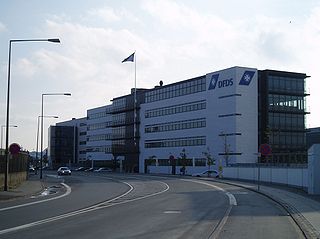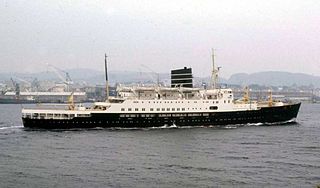See also
- Italian submarine Archimede, either of two submarines by that name
Several ships have been named Archimedes for Archimedes:

A steamship, often referred to as a steamer, is a type of steam-powered vessel, typically ocean-faring and seaworthy, that is propelled by one or more steam engines that typically move (turn) propellers or paddlewheels. The first steamships came into practical usage during the early 1800s; however, there were exceptions that came before. Steamships usually use the prefix designations of "PS" for paddle steamer or "SS" for screw steamer. As paddle steamers became less common, "SS" is assumed by many to stand for "steamship". Ships powered by internal combustion engines use a prefix such as "MV" for motor vessel, so it is not correct to use "SS" for most modern vessels.
USS Grampus may refer to:

DFDS is a Danish international shipping and logistics company. The company's name is an abbreviation of Det Forenede Dampskibs-Selskab. DFDS was founded in 1866, when C.F. Tietgen merged the three biggest Danish steamship companies of that day.

The Pacific Mail Steamship Company was founded April 18, 1848, as a joint stock company under the laws of the State of New York by a group of New York City merchants. Incorporators included William H. Aspinwall, Edwin Bartlett, Henry Chauncey, Mr. Alsop, G.G. Howland and S.S. Howland.

Kościuszko was a passenger steamship that was built in Scotland in 1915, sailed as a troopship in both World Wars, was an ocean liner between the wars, carried displaced persons after World War II and was scrapped in England in 1950.
A number of steamships have been named Indus, including:-

SM U-117 was a Type UE II long-range minelayer submarine of the Imperial German Navy. She was laid down in 1917, at Hamburg, Germany, by Aktiengesellschaft Vulcan and launched on 10 December 1917. She was commissioned in the Imperial German Navy on 28 March 1918, with Kapitänleutnant Otto Dröscher in command. After shakedown, U-117 was posted to the U-Kreuzer Verband on 1 June 1918. Over the next five weeks, she completed fitting out at Kiel.
Britannia may refer to any one of a large number of ships:

SS Archimedes was a steamship built in Britain in 1839. She was the world's first steamship to be driven successfully by a screw propeller.

The Bergen Steamship Company (BDS), was founded in 1851 by Michael Krohn to operate a shipping service between the Norwegian ports of Bergen, Stavanger, and Kristiansand and the German port of Hamburg with the paddle steamer Bergen. The company funnel was black with three widely spaced narrow white bands.

SS Rio de Janeiro was a German cargo steamship, owned by the Hamburg Südamerikanische shipping company and registered in Hamburg. She was built as Santa Ines in 1914, and renamed Rio de Janeiro in 1921. Until World War II she carried passengers and freight between Germany and South America.
SS Loreto, formerly Astrée, was a 1,069 GRT cargo steamship that was built in England in 1912 for French owners and bought in 1933 by Italian owners who renamed her Loreto. In 1942 a Royal Navy submarine sank her in the Tyrrhenian Sea, killing 130 British Indian Army prisoners of war who were aboard.
Lamport and Holt was a UK merchant shipping line. It was founded as a partnership in 1845, reconstituted as a limited company in 1911 and ceased trading in 1991.
A number of ships have been named Timandra for the mythological Timandra:

The SS Runic was a steamship built at Harland and Wolff in Belfast for the White Star Line which entered service in 1901. Runic was the fourth of five Jubilee-class ocean liners built for White Star's Australia service along with her sister ship SS Suevic, where she ran on the Liverpool–Cape Town–Sydney route. She served this route until she was requisitioned for use as a war transport between 1915 and 1919, before returning to the Australia service.
Several vessels have been named Aberdeen: